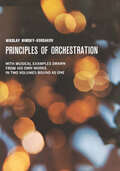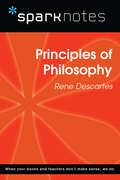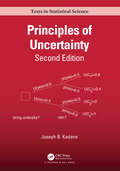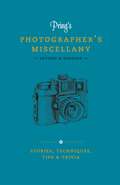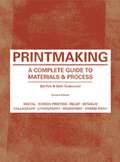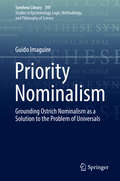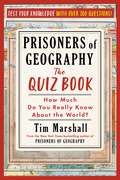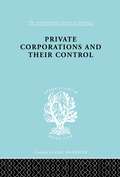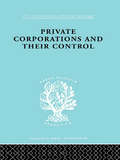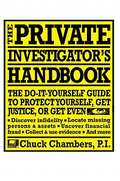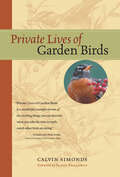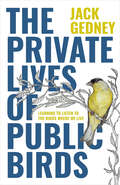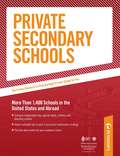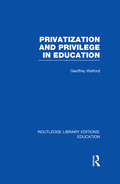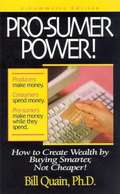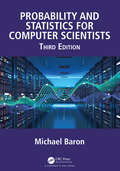- Table View
- List View
Principles of Microeconomics, 3e
by David Shapiro Daniel Macdonald Steven A. GreenlawPrinciples of Microeconomics 3e covers the scope and sequence of most one-semester introductory microeconomics courses. The third edition takes a balanced approach to the theory and application of microeconomics concepts. The text uses conversational language and ample illustrations to explore economic theories and provides a wide array of examples using both fictional and real-world applications. The third edition has been carefully and thoroughly updated to reflect recent developments, as well as to provide a deeper background in diverse contributors and their impacts on economic thought and analysis. For example, the third edition highlights the research and views of a broader group of economists. This is the official print version of this OpenStax textbook. OpenStax makes full-color hardcover and B&W paperback print copies available for students who prefer a hardcopy textbook to go with the free digital version of this OpenStax title. The textbook content is exactly the same as the OpenStax digital book. This textbook is available for free download at the OpenStax dot org website, but as many students prefer to study with hardcopy books, we offer affordable OpenStax textbooks for sale through Amazon as well as most campus bookstores.
Principles of Orchestration
by Nikolai Rimsky-Korsakov"To orchestrate is to create, and this cannot be taught," wrote Nikolay Rimsky-Korsakov, the great Russian composer whose genius for brilliant, highly colored orchestration is unsurpassed. But invention, in all art, is closely allied to technique, and technique can be taught. This book, therefore, which differs from most other texts on the subject because of its tremendous wealth of musical examples and its systematic arrangement of material according to each constituent of the orchestra, will undoubtedly be of value to any music student. It is a music classic, perhaps the only book on classical orchestration written by a major composer.In it, the composer aims to provide the reader with the fundamental principles of modern orchestration from the standpoint of brilliance and imagination, and he devotes considerable space to the study of tonal resonance and orchestral combination. In his course, he demonstrates such things as how to produce a good-sounding chord of certain tone-quality, uniformly distributed; how to detach a melody from its harmonic setting; correct progression of parts; and other similar problems.The first chapter is a general review of orchestral groups, with an instrument-by-instrument breakdown and material on such technical questions as fingering, range, emission of sound, etc. There follows two chapters on melody and harmony in strings, winds, brasses, and combined groups. Chapter IV, Composition of the Orchestra, covers different ways of orchestrating the same music; effects that can be achieved with full tutti; tutti in winds, tutti pizzicato, soli in the strings, etc.; chords; progressions; and so on. The last two chapters deal with opera and include discussion of solo and choral accompaniment, instruments on stage or in the wings, technical terms, soloists (range, register, vocalization, vowels, etc.), voices in combination, and choral singing. Immediately following this text are some 330 pages of musical examples drawn from "Sheherazade," the "Antar Symphony," "Capriccio Espagnol," "Sadko," "Ivan the Terrible," "Le Coq d'Or," "Mlada," "The Tsar's Bride," and others of Rimsky-Korsakov's works. These excerpts are all referred to in the text itself, where they illustrate, far better than words, particular points of theory and actual musical practice. They are largely responsible for making this book the very special (and very useful) publication it is.This single-volume edition also includes a brief preface by the editor and extracts from Rimsky-Korsakov's 1891 draft and final versions of his own preface, as well as an appendixed chart of single tutti chords in the composer's works.
Principles of Philosophy (SparkNotes Philosophy Guide)
by SparkNotesPrinciples of Philosophy (SparkNotes Philosophy Guide) Making the reading experience fun! SparkNotes Philosophy Guides are one-stop guides to the great works of philosophy–masterpieces that stand at the foundations of Western thought. Inside each Philosophy Guide you&’ll find insightful overviews of great philosophical works of the Western world.
Principles of Uncertainty (Chapman & Hall/CRC Texts in Statistical Science)
by Joseph B. KadanePraise for the first edition: Principles of Uncertainty is a profound and mesmerising book on the foundations and principles of subjectivist or behaviouristic Bayesian analysis. … the book is a pleasure to read. And highly recommended for teaching as it can be used at many different levels. … A must-read for sure!—Christian Robert, CHANCEIt's a lovely book, one that I hope will be widely adopted as a course textbook.—Michael Jordan, University of California, Berkeley, USALike the prize-winning first edition, Principles of Uncertainty, Second Edition is an accessible, comprehensive text on the theory of Bayesian Statistics written in an appealing, inviting style, and packed with interesting examples. It presents an introduction to the subjective Bayesian approach which has played a pivotal role in game theory, economics, and the recent boom in Markov Chain Monte Carlo methods. This new edition has been updated throughout and features new material on Nonparametric Bayesian Methods, the Dirichlet distribution, a simple proof of the central limit theorem, and new problems.Key Features: First edition won the 2011 DeGroot Prize Well-written introduction to theory of Bayesian statistics Each of the introductory chapters begins by introducing one new concept or assumption Uses "just-in-time mathematics"—the introduction to mathematical ideas just before they are applied
Pring's Photographer's Miscellany: Stories, Techniques, Tips & Trivia
by Roger Pring***How did Kodak company get its name? Who invented the Minox spy camera? Were there really fax machines in the mid-19th century? And what would a photographer use 'Mod Podge' for? The answers to all these questions and many, many more can be found in this intriguing compendium of photographic fascination compiled by Roger Pring.Beautifully packaged, full of arresting images and exquisitely typeset by the author himself, Pring's Photographer's Miscellany will make an intriguing gift for all photographers. Dipping into the book will reveal the origins of the photographer's craft, tips and tricks of the greats, a host of revealing quotes and fascinating trivia: and you'll not only be richly entertained, you'll certainly learn something you can use next time you shoot.
Pring's Photographer's Miscellany: Stories, Techniques, Tips & Trivia
by Roger Pring***How did Kodak company get its name? Who invented the Minox spy camera? Were there really fax machines in the mid-19th century? And what would a photographer use 'Mod Podge' for? The answers to all these questions and many, many more can be found in this intriguing compendium of photographic fascination compiled by Roger Pring.Beautifully packaged, full of arresting images and exquisitely typeset by the author himself, Pring's Photographer's Miscellany will make an intriguing gift for all photographers. Dipping into the book will reveal the origins of the photographer's craft, tips and tricks of the greats, a host of revealing quotes and fascinating trivia: and you'll not only be richly entertained, you'll certainly learn something you can use next time you shoot.
Printmaking Second Edition: A Complete Guide to Materials & Process
by Bill Fick Beth GrabowskiPrintmaking is a practical and comprehensive guide to printmaking techniques. This fully updated edition includes expanded chapters on digital and mixed media processes, and a brand new 'Print & Make' chapter, which explores the opportunities for creative expression within the many processes available to print makers. The more traditional techniques of relief, intaglio, collograph, lithography, screen printing and monoprint have also been refreshed with the addition of new images showing a broader range of subject matter, including more contemporary prints and international artists. Each technique is explored from the development of the printing or digital matrix, through the different stages of creation to image output. Guidance on how to set up a print studio, sections on troubleshooting techniques and the inclusion of up-to-date lists of suppliers, workshops and galleries make this an essential volume for beginner and experienced printmakers alike.
Printmaking Second Edition: A Complete Guide to Materials & Process
by Bill Fick Beth GrabowskiPrintmaking is a practical and comprehensive guide to printmaking techniques. This fully updated edition includes expanded chapters on digital and mixed media processes, and a brand new 'Print & Make' chapter, which explores the opportunities for creative expression within the many processes available to print makers. The more traditional techniques of relief, intaglio, collograph, lithography, screen printing and monoprint have also been refreshed with the addition of new images showing a broader range of subject matter, including more contemporary prints and international artists. Each technique is explored from the development of the printing or digital matrix, through the different stages of creation to image output. Guidance on how to set up a print studio, sections on troubleshooting techniques and the inclusion of up-to-date lists of suppliers, workshops and galleries make this an essential volume for beginner and experienced printmakers alike.
Printreading for Residential Construction, Sixth Edition
by Thomas E. Proctor Leonard P. ToenjesPrintreading for Residential Constructionpresents printreading fundamentals and provides printreading activities related to residential construction. Topics presented include sketching, computer-aided design (CAD), trade math symbols and abbreviations, plot plans, floor plans, elevations, sections, and details. This new edition provides information on revised building codes, LEED for Homes, green building practices, advanced house framing techniques, insulation, and the whole-house systems approach. Content Overview Construction Documents Working Drawing Concepts Trade Math Symbols and Abbreviations Plot Plans Floor Plans Elevations Sections Details Trade Information - Foundations, Framing, and Finishes Trade Information - Electrical, Plumbing, and HVAC Final Review and Exams Appendix Glossary Index
Priority Nominalism: Grounding Ostrich Nominalism as a Solution to the Problem of Universals (Synthese Library #397)
by Guido ImaguireThis monograph details a new solution to an old problem of metaphysics. It presents an improved version of Ostrich Nominalism to solve the Problem of Universals. This innovative approach allows one to resolve the different formulations of the Problem, which represents an important meta-metaphysical achievement.In order to accomplish this ambitious task, the author appeals to the notion and logic of ontological grounding. Instead of defending Quine’s original principle of ontological commitment, he proposes the principle of grounded ontological commitment. This represents an entirely new application of grounding.Some metaphysicians regard Ostrich Nominalism as a rejection of the problem rather than a proper solution to it. To counter this, the author presents solutions for each of the formulations. These include: the problem of predication, the problem of abstract reference, and the One Over Many as well as the Many Over One and the Similar but Different variants.This book will appeal to anyone interested in contemporary metaphysics. It will also serve as an ideal resource to scholars working on the history of philosophy. Many will recognize in the solution insights resembling those of traditional philosophers, especially of the Middle Ages.
Prisoners of Geography: Our World Explained In 12 Simple Maps (illustrated Young Readers Edition) (Politics Of Place Ser. #1)
by Tim Marshall“For curious children ages 7–15, Prisoners of Geography has lots to fascinate.”—The Wall Street Journal The secret world history written in the mountains, rivers, and seas that shape every country’s politics, economy, and international relations—and our own lives—is revealed in this illustrated young readers edition of Prisoners of Geography, the million-copy international bestseller. History is a story—and it’s impossible to tell the whole tale without understanding the setting. In this eye-opening illustrated edition of the international bestseller Prisoners of Geography, you’ll learn to spot connections between geography and world affairs in ways you never noticed before. How did the US’s rivers help it become a superpower? Why are harsh, cold and swampy Siberia and the Russian Far East two of that country’s most prized regions? How come Japan prefers to trade along the coasts instead of across its land? What do the Himalayas have to do with war? With colorful maps that capture every continent and region, plus hundreds of illustrations that illuminate how our surroundings shape us, this one-of-a-kind atlas will inspire curious minds of all ages!
Prisoners of Geography: How Much Do You Really Know About the World?
by Tim MarshallPut your geographical and political knowledge to the test and discover your geography IQ with this engaging collection of 300+ questions, puzzles, word games, and maps from New York Times bestselling author Tim Marshall.&“In an ever more complex, chaotic, and interlinked world, Prisoners of Geography is a concise and useful primer on geopolitics&” (Newsweek). Ever wonder just how much you really know about the world? Now, in this interactive quiz book based on the New York Times bestselling Prisoners of Geography, you can test yourself on topics every world citizen should know. Do you know your continents from your countries, your landmarks from your latitudes, your mountain ranges from your rivers? Covering every area of the world—from New Orleans to NATO and from Russia to Rhode Island—the book tests your expertise with a variety of questions, puzzles, word games and maps, designed to challenge you while expanding your world knowledge. With refreshing insights and his trademark wit, Marshall continues to make complex geopolitical strategies that shape the world accessible to millions around the globe. From trivia fans to international history buffs, this illuminating, interactive quiz book is a fun way to challenge your friends and family and discover who is the ultimate expert on world affairs.
Privacy and Power
by Miller Russell A.Edward Snowden's leaks exposed fundamental differences in the ways Americans and Europeans approach the issues of privacy and intelligence gathering. Featuring commentary from leading commentators, scholars and practitioners from both sides of the Atlantic, the book documents and explains these differences, summarized in these terms: Europeans should 'grow up' and Americans should 'obey the law'. The book starts with a collection of chapters acknowledging that Snowden's revelations require us to rethink prevailing theories concerning privacy and intelligence gathering, explaining the differences and uncertainty regarding those aspects. An impressive range of experts reflect on the law and policy of the NSA-Affair, documenting its fundamentally transnational dimension, which is the real location of the transatlantic dialogue on privacy and intelligence gathering. The conclusive chapters explain the dramatic transatlantic differences that emerged from the NSA-Affair with a collection of comparative cultural commentary.
Privacy, Big Data, and the Public Good
by Julia Lane Victoria Stodden Stefan Bender Helen Nissenbaum Julia Lane Victoria Stodden Stefan BenderMassive amounts of data on human beings can now be analyzed. Pragmatic purposes abound, including selling goods and services, winning political campaigns, and identifying possible terrorists. Yet 'big data' can also be harnessed to serve the public good: scientists can use big data to do research that improves the lives of human beings, improves government services, and reduces taxpayer costs. In order to achieve this goal, researchers must have access to this data - raising important privacy questions. What are the ethical and legal requirements? What are the rules of engagement? What are the best ways to provide access while also protecting confidentiality? Are there reasonable mechanisms to compensate citizens for privacy loss? The goal of this book is to answer some of these questions. The book's authors paint an intellectual landscape that includes legal, economic, and statistical frameworks. The authors also identify new practical approaches that simultaneously maximize the utility of data access while minimizing information risk.
Private Corporations and their Control: Part 1 (International Library of Sociology #Vol. 160)
by A.B. LevyFirst published in 1998. Routledge is an imprint of Taylor & Francis, an informa company.
Private Corporations and their Control: Part 2 (International Library of Sociology #Vol. 160)
by A.B. LevyFirst published in 1998. Routledge is an imprint of Taylor & Francis, an informa company.
The Private Investigator Handbook
by Chuck ChambersChuck Chambers has seen it all in his 22 years as a P. I. , working thousands of cases. His hands-on experience and hard-nosed detective work has made him one of the most sought-after private investigators in the business. Here, Chambers shares his insider expertise, with true case histories from his files, tricks of the trade, and step-by-step advice to help readers be able to: - Catch a cheating spouse - Uncover hidden assets, monetary malfeasance, and fraud - Tail and track a mark - Use the Internet to get information on anything and anyone - Protect one's privacy - Prepare an intelligence file on anyone-on and off line - Find and preserve legal evidence *The Private Investigator's Handbook is as fascinating to read as it is useful for anyone looking to get the undercover legal help they need, and the peace of mind they deserve. .
Private Lives of Garden Birds
by Julie Zickefoose Calvin Simonds Scott ShalawayBrimming with stories, wisdom, and expert knowledge, this delightful book gives enthusiasts a peek into the private worlds of eleven North American birds: swallows, blue jays, chickadees, song sparrows, house sparrows, phoebes, mockingbirds, crows, red-winged blackbirds, robins, and hummingbirds. Calvin Simonds shows you how to really observe these birds -- how to interpret the caws of crows, recognize blue jays from their facial markings, understand the flight patterns of swallows. You'll be enthralled as you eavesdrop on a group of sparrows trading songs in a "hootenanny," feel the dry grip of a chickadee's claws on your fingers, tramp through a summer meadow to visit a phoebe, and much more.
The Private Lives of Public Birds: Learning to Listen to the Birds Where We Live
by Jack GedneyA book to help the ordinary birdwatcher appreciate the fascinating songs, stories, and science of common birds Jack Gedney’s studies of birds provide resonant, affirming answers to the questions: Who is this bird? In what way is it beautiful? Why does it matter? Masterfully linking an abundance of poetic references with up-to-date biological science, Gedney shares his devotion to everyday Western birds in fifteen essays. Each essay illuminates the life of a single species and its relationship to humans, and how these species can help us understand birds in general. A dedicated birdwatcher and teacher, Gedney finds wonder not only in the speed and glistening beauty of the Anna’s hummingbird, but also in her nest building. He acclaims the turkey vulture’s and red-tailed hawk’s roles in our ecosystem, and he venerates the inimitable California scrub jay’s work planting acorns. Knowing that we hear birds much more often than we see them, Gedney offers his expert’s ear to help us not only identify bird songs and calls but also understand what the birds are saying. The crowd at the suet feeder will never look quite the same again. Join Gedney in the enchanted world of these not-so-ordinary birds, each enlivened by a hand-drawn portrait by artist Anna Kus Park.
Private Secondary Schools
by Peterson'sPeterson's Private Secondary Schools is everything parents need to find the right private secondary school for their child. This valuable resource allows students and parents to compare and select from more that 1,500 schools in the U.S. and Canada, and around the world. Schools featured include independent day schools, special needs schools, and boarding schools (including junior boarding schools for middle-school students). Helpful information listed for each of these schools include: school's area of specialization, setting, affiliation, accreditation, tuition, financial aid, student body, faculty, academic programs, social life, admission information, contacts, and more. Also includes helpful articles on the merits of private education, planning a successful school search, searching for private schools online, finding the perfect match, paying for a private education, tips for taking the necessary standardized tests, semester programs and understanding the private schools' admission application form and process.
Private Secondary Schools: Traditional Day and Boarding Schools
by Peterson'sPeterson's Private Secondary Schools: Traditional Day and Boarding Schools is everything parents need to find the right day or boarding private secondary school for their child. Readers will find hundreds of school profiles plus links to informative two-page in-depth descriptions written by some of the schools. Helpful information includes the school's area of specialization, setting, affiliation, accreditation, subjects offered, special academic programs, tuition, financial aid, student profile, faculty, academic programs, student life, admission information, contacts, and much more.
Privatization and Privilege in Education (Routledge Library Editions: Education)
by Geoffrey WalfordCan privilege be bought? Arguments have raged over whether private education in the UK is ‘the cement in the wall’ dividing British society, or whether parental choice is, as has also been argued ‘a key component of a free society’. The author here describes the traditional private sector schools, paying attention to the ways in which parents can purchase privilege for their children through attendance at such schools. He argues that the privatized system is kept under tight control if a growth in social and educational inequality and a deepening of social class and ethnic group division is to be avoided. The book is unique in combining an account of private schools in Britain with an examination of the process of privatization.
Pro Paint & Body HP1563
by Jim Richardson Tom HorvathThis is a revised and updated edition of one of the bestselling paint handbooks in the industry. It includes current information on HVLP paint guns and equipment and waterborne paint technology. It also has sections on hammer and dolly, paintless dent removal, patching panels, spray guns and compressors, paint prep, shooting paint, color sanding, plastic bumper repair, and custom paint tips and tricks.
Pro-Sumer Power II! How to Create Wealth by Being Smarter, Not Cheaper, and Referring Others to Do the Same
by Bill QuainAccording to marketing expert Dr. Bill Quain, average people can produce above-average wealth through the power of pro-suming. Pro-sumer Power! is a must read for people who would love to create income - instead of "out-go" - when they shop.
Probability and Statistics for Computer Scientists, Third Edition
by Michael BaronPraise for the Second Edition: "The author has done his homework on the statistical tools needed for the particular challenges computer scientists encounter... [He] has taken great care to select examples that are interesting and practical for computer scientists. ... The content is illustrated with numerous figures, and concludes with appendices and an index. The book is erudite and … could work well as a required text for an advanced undergraduate or graduate course." ---Computing Reviews Probability and Statistics for Computer Scientists, Third Edition helps students understand fundamental concepts of Probability and Statistics, general methods of stochastic modeling, simulation, queuing, and statistical data analysis; make optimal decisions under uncertainty; model and evaluate computer systems; and prepare for advanced probability-based courses. Written in a lively style with simple language and now including R as well as MATLAB, this classroom-tested book can be used for one- or two-semester courses. Features: Axiomatic introduction of probability Expanded coverage of statistical inference and data analysis, including estimation and testing, Bayesian approach, multivariate regression, chi-square tests for independence and goodness of fit, nonparametric statistics, and bootstrap Numerous motivating examples and exercises including computer projects Fully annotated R codes in parallel to MATLAB Applications in computer science, software engineering, telecommunications, and related areas In-Depth yet Accessible Treatment of Computer Science-Related TopicsStarting with the fundamentals of probability, the text takes students through topics heavily featured in modern computer science, computer engineering, software engineering, and associated fields, such as computer simulations, Monte Carlo methods, stochastic processes, Markov chains, queuing theory, statistical inference, and regression. It also meets the requirements of the Accreditation Board for Engineering and Technology (ABET). About the Author Michael Baron is David Carroll Professor of Mathematics and Statistics at American University in Washington D. C. He conducts research in sequential analysis and optimal stopping, change-point detection, Bayesian inference, and applications of statistics in epidemiology, clinical trials, semiconductor manufacturing, and other fields. M. Baron is a Fellow of the American Statistical Association and a recipient of the Abraham Wald Prize for the best paper in Sequential Analysis and the Regents Outstanding Teaching Award. M. Baron holds a Ph.D. in statistics from the University of Maryland. In his turn, he supervised twelve doctoral students, mostly employed on academic and research positions.

